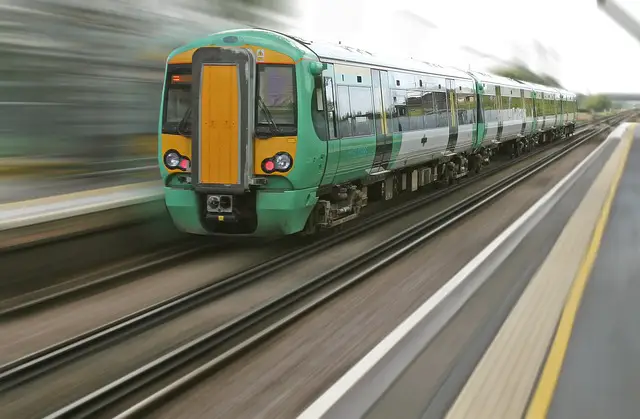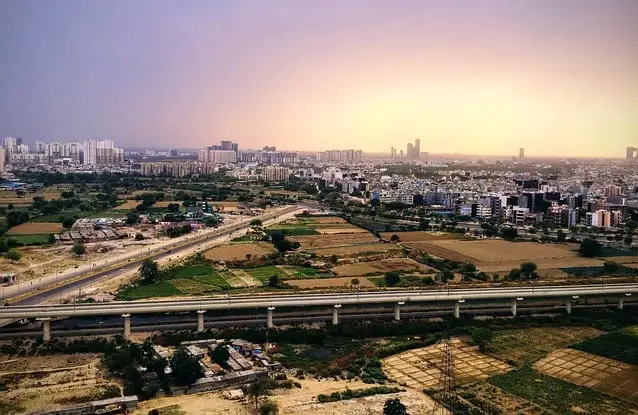What is the Regional Rapid Transit System in India?
The Regional Rapid Transit System (RRTS) is a modern, high-speed transit system designed to improve regional connectivity and public transportation in India. The RRTS connects cities and regional nodes within the National Capital Region (NCR) with the aim of reducing travel time, increasing accessibility and economic opportunities, and promoting sustainable development.
This system of rapid rail corridors focuses on providing comfortable commuter service by using the latest technologies and modern trains like Bombardier Transportation’s rolling stocks. The average speed of the RRTS is approximately 100 kilometres per hour, and its design speed is 160 kilometres per hour, making it one of the fastest modes of transport in the country. The RRTS has become a popular mode of transport for regional travel and has cushioned seating for social inclusiveness and sustainability of the transport sector.

Related: NCRTC_RRTS
Benefits of RRTS
The Regional Rapid Transit System (RRTS) in India provides numerous benefits for the commuting public. Its high speed, high capacity, and comfortable service make it a preferred mode of transport for regional travel within the National Capital Region.
Unlike conventional railway and metro systems, the RRTS is designed for faster and more efficient travel, with an average speed of 100-120 km/h and a design speed of 160 km/h. The high-capacity trains, equipped with modern amenities and cushioned seating, ensure a comfortable commute for passengers.
With its regional connectivity, the RRTS connects various cities and nodes within the National Capital Region, providing faster and more convenient travel options for commuters. For instance, the Delhi-Meerut RRTS Corridor, covering a distance of 82 km, will reduce the travel time between Delhi and Meerut from 3-4 hours to less than an hour. It will also facilitate the movement of commuters and goods, thus promoting economic opportunities and social inclusiveness across the region.
In summary, the RRTS offers numerous benefits such as high speed, high capacity, comfortable service, and regional connectivity, making it a sustainable and reliable mode of transport in the National Capital Region.
Overview of Uttar Pradesh
Uttar Pradesh, abbreviated as UP, is a state located in the northern part of India. Covering an area of 240,928 km², it is the most populous state, with a population of over 200 million people. Uttar Pradesh is also a hub for transportation and connectivity. In recent years, the government of Uttar Pradesh, in collaboration with the National Capital Region Transport Corporation (NCRTC), has been working toward strengthening regional connectivity by building a high-speed transportation system known as the Regional Rapid Transit System (RRTS).
With the aim of providing a sustainable mode of transport, the RRTS offers comfortable commuting service, creating economic opportunities, and connecting regional nodes with Delhi and its surroundings. In this article, we will take a closer look at the overview of the Uttar Pradesh Regional Rapid Transit System, focusing on its design, operational speed, route map, rolling stocks, and other details.
Geography and Population
Uttar Pradesh is a state in northern India with a population of over 200 million, making it the most populated state in the country. The state covers an area of 240,928 square kilometres and is geographically diverse, comprising of the Himalayan foothills, the Gangetic plain, and several major rivers.
Infrastructure and transportation are critical components for the state’s development due to its dense population and growing urbanization. The state’s major cities, including Lucknow, Kanpur, and Agra, are interconnected by a network of highways and railways, which serve as the primary modes of transport. However, with the population increasing, there is a need for sustainable and modern transportation systems.
The Regional Rapid Transit System (RRTS) is set to revolutionize transportation in the state. The RRTS is a high-speed rail network that will connect major cities in the National Capital Region (NCR), including Delhi, Ghaziabad, Meerut, and Alwar.
The RRTS will create regional connectivity, boost economic opportunities, and promote sustainable development in the state. The cities along the RRTS corridors, including Meerut South, Meerut North, and Shatabdi Nagar, will benefit from improved access to education, healthcare facilities, and job opportunities. Additionally, the RRTS will cut down travel time, increase public transportation options, and reduce the carbon footprint.
In conclusion, Uttar Pradesh’s population and geography demand a sustainable and modern transportation system. The RRTS will provide regional connectivity, promote economic opportunities, and improve the quality of life for the people of Uttar Pradesh.
Economy and Infrastructure
Uttar Pradesh is a state in North India that is home to over 200 million people. The economy of Uttar Pradesh is largely dependent on agriculture, with around 70% of its population engaged in farming. The state also has a growing service sector, with industries ranging from Information technology to tourism. However, the infrastructure in Uttar Pradesh remains inadequate due to a lack of investment in the past, which has limited the growth of other industries.
The existing transport networks in Uttar Pradesh are primarily road-based, with a limited railway network. This has resulted in poor regional connectivity and has hindered the movement of commuters between cities and villages. The National Capital Region Transport Corporation (NCRTC) has taken up the responsibility to build and operate Regional Rapid Transit System (RRTS) in the state.
The RRTS is a fast, comfortable and sustainable mode of public transportation designed to connect all regional nodes to the national capital region. The network will cover around 850 kilometres and will connect Delhi with Meerut, Alwar and Panipat with high-speed corridors. It is expected that the RRTS project will boost regional connectivity, encourage economic opportunities and promote sustainable development in the region.
Existing Transport Networks in UP
Uttar Pradesh boasts a well-developed transport network, comprising of railways, highways, and airways. Indian Railways is the primary mode of long-distance travel in the state, with major railway stations like Kanpur Central, Lucknow Junction, and Varanasi Junction providing access to different parts of the country. Additionally, highways like the NH-2, NH-24, and NH-28, connect Uttar Pradesh with other states. The state also has several airports, such as the Chaudhary Charan Singh International Airport in Lucknow and the Lal Bahadur Shastri International Airport in Varanasi, providing domestic and international connectivity.
These transport networks have had a significant impact on the economy and mobility in Uttar Pradesh. The railways, in particular, have played a crucial role in the region’s development, facilitating the movement of goods and people from one place to another. The state is also increasingly becoming an attractive destination for businesses, thanks to the enhanced connectivity and ease of movement within the state.
In conclusion, Uttar Pradesh has a robust and well-connected transport network that has contributed immensely to the state’s economic growth and social mobility. The development of modern transport infrastructure is critical to sustaining the region’s progress, facilitating efficient movement of people and goods, promoting social inclusiveness, and driving sustainable development.
Delhi-Meerut RRTS Corridor
The Delhi-Meerut RRTS corridor is set to transform regional travel and public transportation in India, connecting the national capital with Meerut in Uttar Pradesh. The project is being implemented by the National Capital Region Transport Corporation (NCRTC) and is expected to reduce travel time between the two cities from 3-4 hours to just 60 minutes. The 82-km corridor will have 24 stations, including Meerut South, Meerut North, and Shatabdi Nagar.

The project aims to enhance regional connectivity, promote sustainable development, and create economic opportunities for regional nodes. The corridor will be powered by state-of-the-art rolling stocks from Bombardier Transportation and will have comfortable cushioned seating, offering commuters a comfortable and sustainable mode of transport. The project is expected to transform the transport sector in the region, providing a modern and efficient rapid transit system for the movement of commuters.
Route Description and Corridors
The Delhi-Meerut RRTS corridor is a high-speed rail project aimed at improving regional travel and public transportation in the National Capital Region. The corridor will cover a distance of 82.15 km and has been divided into two corridors – Delhi-Ghaziabad-Meerut and Sahibabad-Duhai. The entire corridor is expected to have an average speed of 100 km/h and a design speed of 160 km/h, making it one of the fastest trains in the country.
The corridor will have 24 stations and 2 depots, including Sarai Kale Khan and Sahibabad. These stations will be located at major regional nodes, providing economic opportunities and access to education. The first 17-km priority section of the corridor will have 5 stations, including Shatabdi Nagar, Meerut South, Meerut Central, Meerut North, and Modipuram.
The RRTS has been designed to integrate with other modes of transport, such as the Delhi Metro, to provide comfortable and sustainable commuter service. The trains will have platform screen doors for passenger safety and will use modern rolling stock provided by Bombardier Transportation. The RRTS will also reduce air pollutants, making it a step towards sustainable development in the transport sector.
Also Read:
- Analysing Integrated Public Transport in International cities
- 7 Benefits of Public Transportation
- Good Public Transportation – A necessity for sustainable settlements
- Examples of Car Free Cities (Pedestrian cities)
- Facts about the Delhi Metro!
- The Importance of Public Transportation in Urban Planning